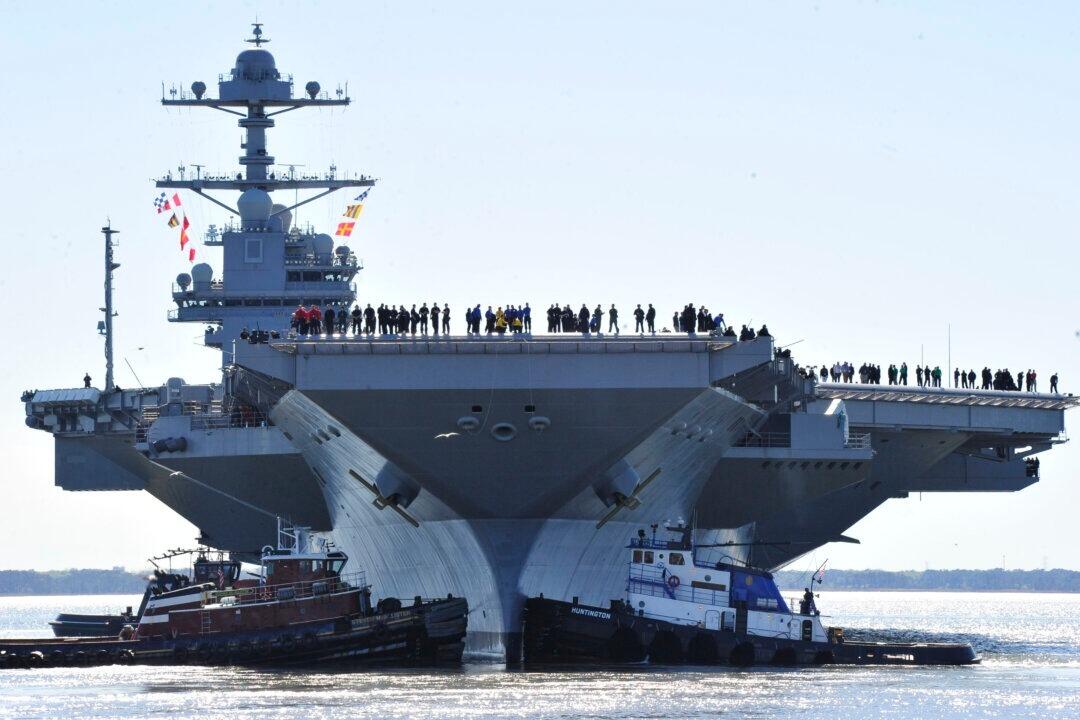US Navy Modernizing To Counter China's Military By 2027
Authored by Antonio Graceffo via The Epoch Times,
The U.S. Navy has released a document outlining its plans to match and exceed Beijing’s goal of modernizing its military by 2027, aiming to be prepared for a potential conflict with the Chinese regime.
The Chinese Communist Party (CCP) has directed the People’s Liberation Army (PLA) to be fully modernized and prepared for war by 2027, coinciding with the PLA’s 100th anniversary. This timeline has raised concerns about a possible invasion of Taiwan, as Chinese leader Xi Jinping focuses on military reforms to ensure the PLA can deter or win a conflict over the island.
The CCP’s strategy goes beyond expanding its navy. It incorporates multi-domain precision warfare, dual-use infrastructure (like airfields and maritime militias), and an expanding nuclear arsenal—and it is supported by the world’s largest shipbuilding capacity.
The U.S. Navy’s 2024 Navigation Plan, led by Adm. Lisa Franchetti, focuses on preparing for a potential conflict with communist China by 2027. Central to this strategy is Project 33, which aims at enhancing the Navy’s long-term advantage and operational readiness. The plan prioritizes modernizing equipment and improving force deployment capabilities, particularly by scaling up the use of robotic and autonomous systems for swift, decisive responses, especially in the Indo-Pacific region.
Project 33 sets two key goals: achieving 80 percent combat readiness for ships, aircraft, and submarines by 2027, and integrating advanced technologies like artificial intelligence and unmanned systems. These initiatives are designed to strengthen the Navy’s ability to respond effectively to emerging threats, specifically focusing on maintaining superiority in the Indo-Pacific.
The U.S. Navy aims to develop three key priorities: long-range fires, non-traditional sea denial, and terminal defense. Long-range fires enable the Navy to strike from a safe distance using advanced missiles and precision-guided weapons, enhancing power projection. Non-traditional sea denial employs methods like cyber warfare, drones, and electromagnetic operations to block adversary access to strategic maritime areas. Terminal defense focuses on protecting naval assets with advanced missile and anti-aircraft systems designed to intercept threats in their final phase.
The U.S. Navy is enhancing its command-and-control capabilities by developing Maritime Operations Centers (MOCs), which are critical for fleet-level warfare. These centers serve as nerve hubs, coordinating naval forces across multi-domain environments, including land, sea, air, space, and cyberspace. MOCs are essential for managing real-time information, directing fleet movements, and overseeing key functions like intelligence, logistics, and communications.
Franchetti stresses the need to mirror China’s military modernization, particularly in integrating technologies like artificial intelligence. To stay competitive in an information-driven battlespace, the Navy is developing MOCs as full-fledged warfighting systems, ensuring they are resilient, adaptable, and ready for decentralized operations. By 2027, the Navy plans to certify MOCs across all fleet headquarters, starting with the Pacific Fleet. These centers will enhance command and control, intelligence, fires, and sustainment functions, boosting decision-making and operational capabilities during crises and conflicts.
The U.S. Navy is closely studying current global conflicts to shape its approach to future sea control. Ukraine’s effective use of missiles, drones, and digital tools against Russian forces has provided key insights for U.S. military strategies, particularly for potential conflicts in the Indo-Pacific. Additionally, the Navy has observed the role drones and ballistic missiles have played in battles against Yemen’s Houthi rebels in the Red Sea, further informing how the Navy prepares for modern warfare. These lessons are crucial for adapting to evolving threats and ensuring readiness in an increasingly complex battlespace.
Unmanned vehicles and weapons systems have played a crucial role in modern warfare, as seen in both Ukraine and the 2020 Armenia–Azerbaijan conflict. Autonomous and remotely operated systems, like drones, have proven highly effective for reconnaissance, precision strikes, and disrupting enemy logistics, all without risking human lives. Recognizing this shift, Franchetti has prioritized integrating unmanned systems, including naval drones and unmanned underwater vehicles (UUVs), into U.S. Navy operations.
UUVs are key technologies in modern naval operations. These systems come in two types: autonomous underwater vehicles, which operate independently, and remotely operated vehicles, which an operator controls. Often referred to as naval or underwater drones, UUVs perform tasks like surveillance, mine detection, and environmental monitoring. Franchetti views these robotic systems as the future of warfare, not just for their efficiency but for their ability to free up sailors for other vital tasks. By deploying autonomous systems for missions like surveillance or combat, the Navy can reallocate human personnel to areas where their expertise is most needed, enhancing operational flexibility and overall readiness.
The U.S. Navy’s plan prioritizes integrating robotic and autonomous systems into routine operations by 2027, ensuring their active use by commanders in carrier and expeditionary strike groups. The focus is on improving coordination between manned and unmanned teams, particularly in areas like surveillance, fires, logistics, and deception. This initiative is part of a broader strategy to enhance command, control, and overall operational effectiveness in complex, multi-domain environments.
In addition to preparing for a potential conflict over Taiwan, the Navy’s 2024 Navigation Plan prioritizes maintaining a free and open Indo-Pacific, ensuring critical shipping lanes like the Strait of Malacca and Taiwan Strait remain accessible for global trade.
Meanwhile, China’s anti-access/area denial (A2/AD) strategy aims to limit the ability of the United States and its allies to operate freely in key areas such as the East and South China Seas, particularly the Taiwan Strait. Central to China’s military doctrine, A2/AD seeks to shift the strategic balance by making it difficult for external forces to intervene in what Beijing considers its sphere of influence. Despite this, the U.S. Navy is rapidly modernizing to meet these challenges and is prepared to counter the CCP’s regional dominance efforts.
NEVER MISS THE NEWS THAT MATTERS MOST
ZEROHEDGE DIRECTLY TO YOUR INBOX
Receive a daily recap featuring a curated list of must-read stories.




